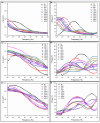In Situ Evaluation of Epoxy Self-Healing Coating by Encapsulated Linseed Oil in Poly(Urea-Formaldehyde-Melamine) Microcapsules
- PMID: 40363410
- PMCID: PMC12073004
- DOI: 10.3390/ma18091906
In Situ Evaluation of Epoxy Self-Healing Coating by Encapsulated Linseed Oil in Poly(Urea-Formaldehyde-Melamine) Microcapsules
Abstract
The development of self-healing coatings represents a promising approach to enhance the durability of metal substrates exposed to corrosive environments, demanding thorough in situ investigations. In this study, poly(urea-formaldehyde-melamine) (PUF) microcapsules containing linseed oil (LO) were synthesized via in situ polymerization to act as healing agents in protective coatings. The microcapsules were characterized using scanning electron microscopy (SEM), optical microscopy (OM), Fourier-transform infrared spectroscopy (FTIR), and thermogravimetric analysis (TGA). The capsules exhibited a regular spherical morphology with an average diameter of 96 µm and an LO encapsulation efficiency of 81 wt%. TGA confirmed their thermal stability up to 200 °C, while FTIR verified the successful encapsulation of LO. For performance evaluation, 10 wt% of the microcapsules was incorporated into an epoxy matrix and applied to carbon steel. Corrosion resistance was evaluated using electrochemical impedance spectroscopy (EIS) in 0.1 mol/L of NaCl solution over 500 h. The coating with microcapsules exhibited a |Z|0.01 of 106 Ω·cm2, higher than the 104 Ω·cm2 observed for the coating without microcapsules, indicating improved barrier properties. Raman spectroscopy confirmed the auto-oxidation of LO at damaged areas, evidencing the self-healing mechanism. Although full barrier recovery was not achieved, the system effectively delayed corrosion progression.
Keywords: Raman spectroscopy; corrosion protection; electrochemical impedance spectroscopy; in situ characterization; linseed oil; organic coatings; polymeric microcapsules; self-healing.
Conflict of interest statement
The authors declare no conflicts of interest.
Figures














References
-
- Lang S., Zhou Q. Synthesis and Characterization of Poly(Urea-Formaldehyde) Microcapsules Containing Linseed Oil for Self-Healing Coating Development. Prog. Org. Coat. 2017;105:99–110. doi: 10.1016/j.porgcoat.2016.11.015. - DOI
-
- Liu T., Ma L., Wang X., Wang J., Qian H., Zhang D., Li X. Self-Healing Corrosion Protective Coatings Based on Micro/Nanocarriers: A Review. Corros. Commun. 2021;1:18–25. doi: 10.1016/j.corcom.2021.05.004. - DOI
-
- Mahajan M.S., Gite V.V. Self-Healing Polyurethane Coatings of Eugenol-Based Polyol Incorporated with Linseed Oil Encapsulated Cardanol-Formaldehyde Microcapsules: A Sustainable Approach. Prog. Org. Coat. 2022;162:106534. doi: 10.1016/j.porgcoat.2021.106534. - DOI
Grants and funding
LinkOut - more resources
Full Text Sources

